The Waxing Moon Wades the Water Constellations, the Evening Bright Planet Party Continues, and Telescope Buying Tips!

Several times a year at the moon’s first quarter phase, a feature called the Lunar X becomes visible in strong binoculars and small telescopes. For a few hours starting at approximately 11:15 pm EST on Monday, December 2, the illuminated rims of the craters Purbach, la Caille, and Blanchinus will combine to form a small, but very obvious X-shape. Unfortunately, this time the event will only be visible from the western americas and in the Pacific Ocean region. Look for the X along the terminator, and about one third of the way up from the southern pole of the moon.
Happy December, Stargazers!
Here are your Astronomy Skylights for the week of December 1st, 2019 by Chris Vaughan. Feel free to pass this along to your friends and send me your comments, questions, and suggested topics. I repost these emails with photos at http://astrogeo.ca/skylights/ where all the old editions will be archived. You can also follow me on Twitter as @astrogeoguy! Unless otherwise noted, all times are Eastern Time. To subscribe to these emails please click this MailChimp link.
I can bring my Digital Starlab portable inflatable planetarium to your school or other daytime or evening event. Contact me through AstroGeo.ca, and we’ll tour the Universe together!
The moon returns to worldwide evening skies this week while wading through the modest water constellations. The brightest planets Venus, Jupiter, and Saturn will dance after sunset – and elusive Mercury and reddish Mars will beacon in the eastern pre-dawn sky. If you are in the market for telescope – read on! Here are your Skylights!
The Moon and Planets – and a Lunar X
This week, the moon will be crossing the evening sky for observers worldwide – and it will be perfectly positioned for an after-dinner peek in binoculars and backyard telescopes. The early sunsets of December mean that even the youngest of observers can explore the moon before bedtime. In fact, this week will deliver the earliest sunsets of the year for mid-northern latitudes.
The moon will wax in phase all week, passing its first quarter phase at 1:58 am EST (or 6:58 UT) on Wednesday morning. The term first quarter refers not to the moon’s appearance, but to the fact that our natural satellite has completed one quarter of its orbit around Earth – counting from new moon. At this point in its orbit, the moon is always positioned in the sky 90 degrees from the sun, and is half-illuminated – on its eastern side. (Looking at the moon, east and west are reversed from their directions on Earth.)
The nights around first quarter are the best times to see the moon’s rugged terrain dramatically lit by slanted sunlight. The most breathtaking magnified views are found along the terminator – the pole-to-pole line that divides the moon’s dark and lit hemispheres. Along that boundary, the sun is close to the lunar horizon – so the shadows cast are long and deep black. Even small topographic features are thrown into stark relief. As the moon progresses in its orbit, its angle from the sun increases, causing it to wax in phase and rise later. At the same time, the terminator migrates from east to west – highlighting new features each night. The bright moon is very easy to photograph through the eyepiece with your smartphone. Give it a try!
At this first quarter, a feature called the Lunar X will become visible in strong binoculars and small telescopes. For a few hours, the illuminated rims of the craters Purbach, la Caille, and Blanchinus will form a small, but quite obvious X-shape located at moon coordinates 2° East and 24° South. That point is on the terminator, about one third of the way up from the southern pole of the moon. The “X” should start to develop around 11:15 pm EST on Tuesday, but the moon will have just set for observers in the Eastern Time Zone. But more westerly observers in the western americas, and in the Pacific Ocean region will be able to see this event.
The moon will wade through the water constellations this week. Tonight (Sunday) and tomorrow (Monday) night the waxing crescent moon will be situated among the dim stars of Capricornus (the Sea-Goat). On Tuesday and Wednesday, the waxing gibbous moon (i.e., now more than half-illuminated) will pass through Aquarius (the Water-Bearer). Then the moon will skip along the meandering boundary between Cetus (the Sea-Monster) and Pisces (the Fishes). Along the way, the moon will pass a palm’s width below (or 6 degrees to the celestial south of) the dim ice giant planets Neptune and Uranus on Wednesday and Sunday, respectively – but the bright moon’s light will overwhelm those dim and distant planets.
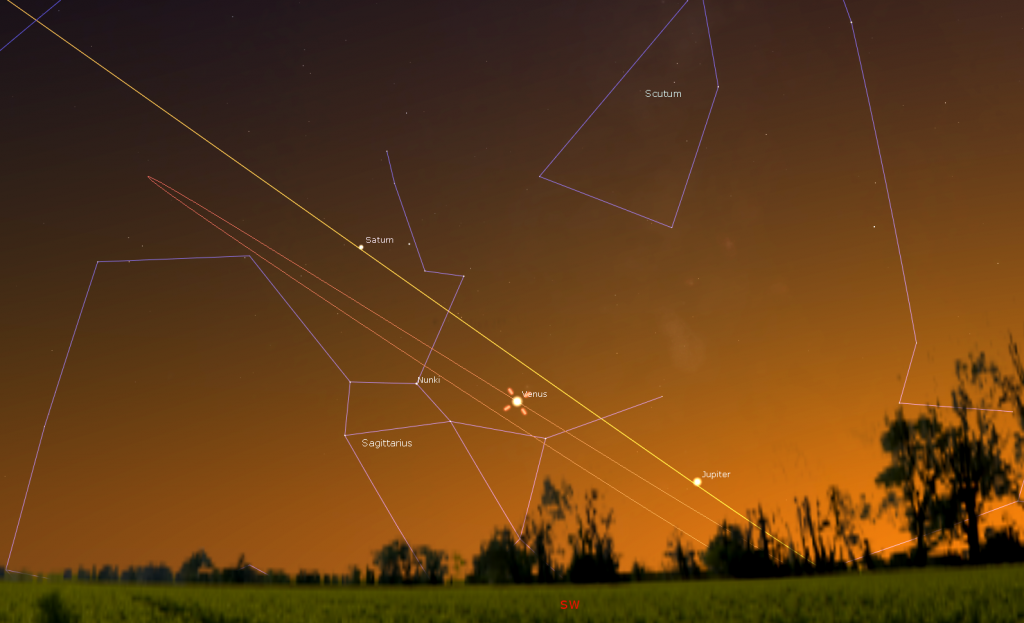
The pretty, bright planet party will continue this week as Venus, Jupiter, and Saturn dance in the western sky after sunset, but you’ll need an unobstructed view of the horizon to the southwest to see them. Once the sun has set and the sky begins to darken after about 5 pm local time, look for medium-bright Jupiter sitting about a palm’s width above the southwestern horizon. Jupiter will be setting shortly before 6 pm local time this week.
Much brighter Venus will be situated to Jupiter’s upper left this week. Venus is currently swinging away from the sun while Jupiter is being carried west towards the sun by Earth’s motion around the sun. Last week Venus and Jupiter passed one another. This week, they will draw farther apart – doubling their separation from 7 degrees to 14 degrees. (Your clenched fist held at arm’s length will span about 10 degrees of the sky.)
Now shining at a spectacularly bright magnitude of -3.9, Venus has been held low in the southwestern post-sunset sky by the shallow angle of the evening ecliptic – but the planet is now ascending out of the surrounding evening twilight. It will set at about 6:30 pm local time.
As Venus flees Jupiter, it will be closing in on Saturn. The yellow-tinted Ringed Planet, which is much less bright than Venus and Jupiter due to its smaller diameter and larger distance from us, is still a reasonably good option for viewing in backyard telescopes. Saturn will set shortly after 7 pm local time this week. Tonight (Sunday), Saturn can be found about a fist’s diameter to the upper left (or 6 degrees to the celestial east) of Venus. By next Sunday evening, Venus will be positioned only a few finger widths below Saturn. Venus will be closest to Saturn on December 10-11.
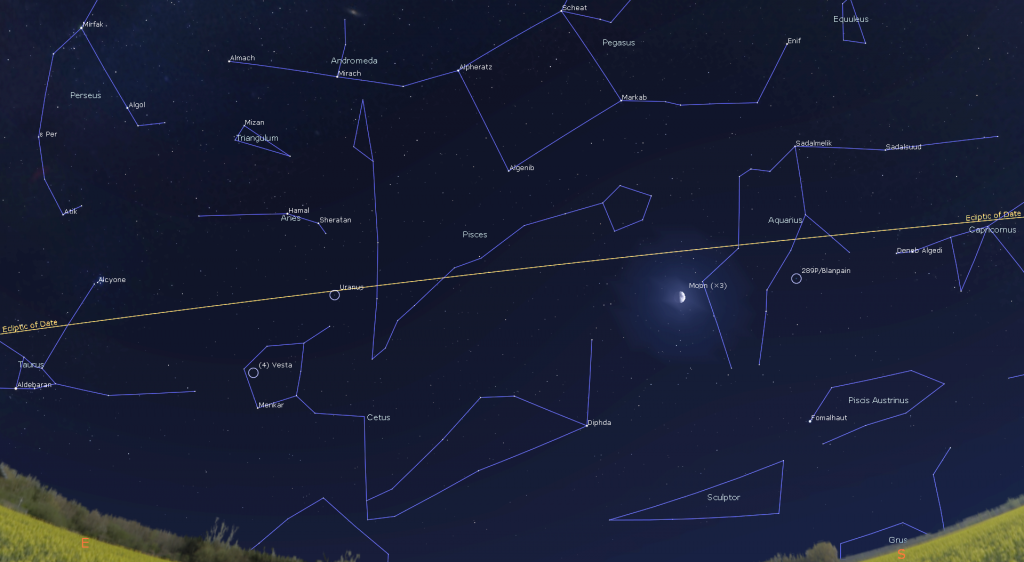
This winter, evening planet-watchers will have to settle for Venus, and the dim and tricky-to-find ice giant planets Uranus and Neptune. Despite their small disk sizes, however, the delightful colours of those two remote planets make them worthy of a look in backyard telescopes.
Distant and dim, blue Neptune is available in the southern evening sky after dark. But it sets at around midnight local time, so you should try to observe it while it is highest in the sky – at 6:30 pm local time. Neptune is situated among the stars of eastern Aquarius (the Water-Bearer), and is positioned a thumb’s width to the right (or 1.5 degrees to the celestial west) of a medium-bright star named Phi (φ) Aquarii. Both blue Neptune and that golden-coloured star will appear together in the field of view of a backyard telescope at low power. When the bright moon is out of the night sky, magnitude 7.9 Neptune is actually visible in binoculars, too. Find Phi Aquarii first and then locate nearby Neptune.

Blue-green Uranus is still near peak visibility for 2019. This month, the planet will be sitting a generous palm’s width to the left (or 7 degrees to the celestial east) of the stars that form the “V” of Pisces (the Fishes). It is also below (or to the celestial south of) Aries (the Ram), and just a palm’s width above the ring of stars that form the head of Cetus (the Whale).
Uranus is observable from dusk until the wee hours of the night. Shining at magnitude 5.7, it is bright enough to see in binoculars and small telescopes under dark skies. To help you find it, I’m posting a detailed star chart here. If you can wait until about 9:30 pm local time to view it, it will be highest in the sky, and you’ll be looking through the least amount of Earth’s disturbing atmosphere.
Mercury and Mars are still putting on a show in the eastern pre-dawn sky – although Mercury will be exiting the scene soon. Red-tinted Mars will rise first – at about 4:50 am local time. From now until October, 2020, Mars will continually grow in brightness in our skies – and will increase in apparent size when viewed in telescopes. In fact, the 2020 Mars opposition will be a terrific excuse to get a telescope now so you can practice viewing the planet during the spring and summer months of 2020!

This latest morning apparition for Mercury has been the best one for Northern Hemisphere observers in 2019, but a poor one for those viewing the planet from mid-southern latitudes. Mercury is still nicely positioned for viewing this week, when it will be found low in the east-southeastern pre-dawn sky. Every morning the planet will descend deeper into the morning twilight. The best viewing time for Mercury will be between 6:30 and 7 am local time.
A few weeks ago, Earth’s orbit carried us between the minor planet (and asteroid) Vesta and the sun – allowing Vesta to be visible all night long, and to appear at its brightest for the year. At magnitude 6.8 this week, Vesta is still well within reach of binoculars and small telescopes. Look for Vesta within the circle of stars that form the head of Cetus (the Whale). The asteroid is only about a finger’s width to the lower right (or 1 degree to the celestial south) of the medium-bright star Menkar. Use the Pleiades star cluster, which is located two fist diameters to Vesta’s upper left, to get you into the neighbourhood.
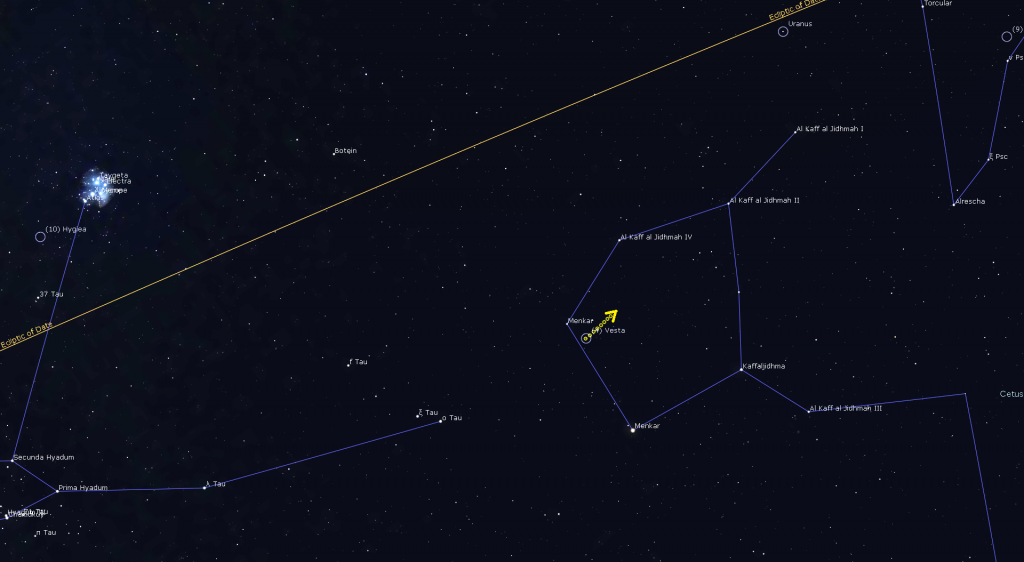
Meteor Shower News
The Geminids Meteor Shower, one of the most spectacular of the year, runs from December 4 to 16 annually – so you can begin to watch for them this week. This shower will peak before dawn on Thursday, December 14, when up to 120 meteors per hour are possible under dark sky conditions. But the full moon in Gemini on the peak night will overwhelm the majority of the meteors for this shower in 2019. So catch a few now while the moon is less intense!
Telescope Buying Tips
A few people have asked me about buying a first telescope. Two of the most important characteristics in telescope performance are its aperture (the diameter of the main “tube”) and the sturdiness of the mount/tripod. The aperture corresponds to the diameter of the main mirror or lens in the telescope – and the larger it is, the more light it can gather, allowing fainter objects to be seen more easily. A larger aperture also increases the telescope’s angular resolution, or sharpness, which is especially helpful for planets.
In a refractor telescope (the type with the lens at the front end of the main tube), look for a minimum diameter of 80-mm. This type of telescope will offer nice views of the brighter planets, the Moon, double stars, and brighter nebulae and clusters. The performance of a telescope improves with the square of the aperture, so an 80 mm telescopes is (80*80)/(70*70) = 1.8 times more powerful than a cheap, 60-mm department store telescope! That’s nearly double the light-gathering ability!
In reflector telescopes (the type with the large mirror inside the bottom of the main tube), diameters of 6 or 8 inches (150-mm to 200-mm) are common and affordable. Because of that aperture scaling rule, they outperform the refractor telescope by showing dimmer galaxies and clusters, especially under a dark sky, while also showing the same brighter objects. (An 8-inch reflector gathers seven times as much light as an 80-mm refractor!)
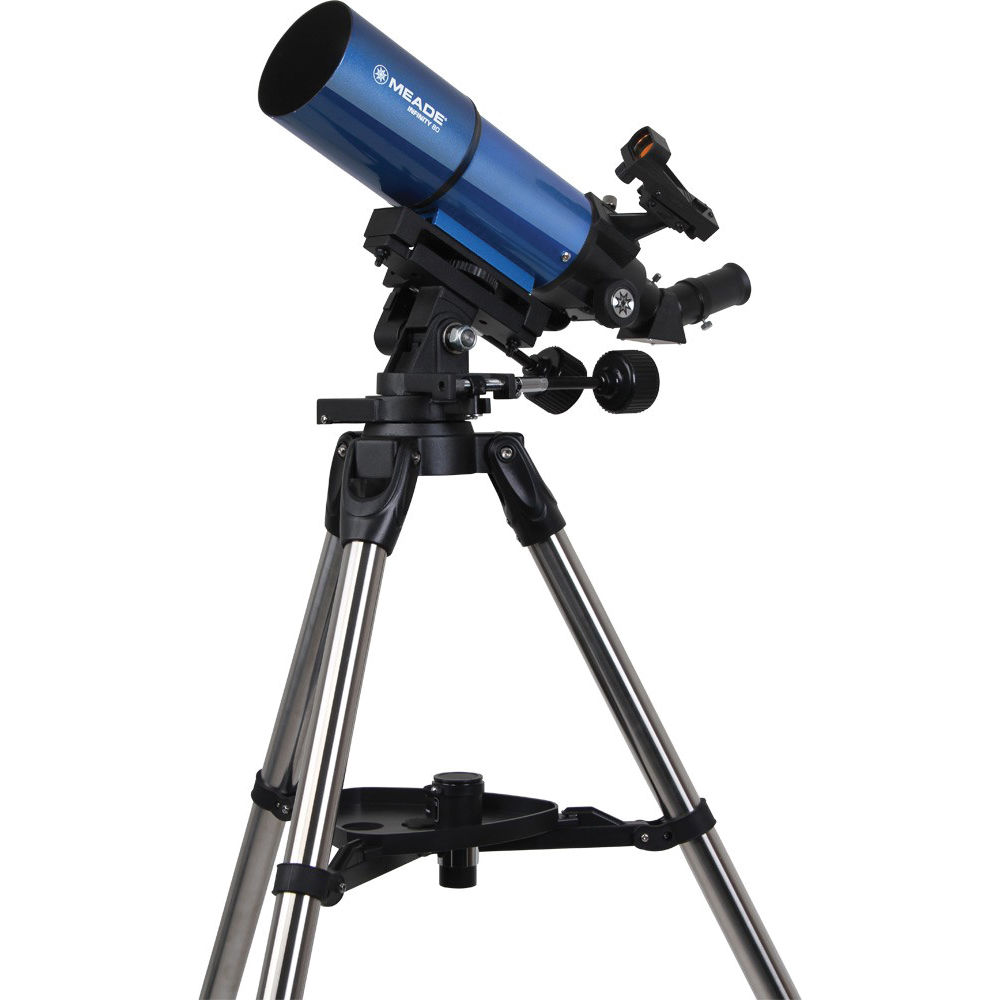
The second important factor when shopping is the mount, including the tripod. A high quality telescope on a rickety mount is practically useless. Every time you touch it, for focusing or centering an object, you set off wild shaking of the image. This is one of the main reasons why cheap department store telescopes are poor investments – people get frustrated when they can’t put objects in the field of view and keep them there.
While computerized telescopes are terrific, I dissuade beginners from buying these pricier systems until they’ve learned the major elements of the sky. These GOTO systems can slew to an object for you – but if you don’t know how to align them, and where to find the target in the sky in the first place, how will you trouble-shoot if you can’t see anything through the eyepiece.
Skywatcher makes a good, affordable series of starter telescopes. Here’s an 80mm diameter model that ticks all the boxes. They have larger aperture versions, too. Look for the “AZ3” part of the model number. It’s a good, lightweight, and sturdy tripod that includes slow motion controls for following the object as the Earth turns. Any other brand with the same specifications should be okay, too, such as this one from Meade Instruments. All inexpensive telescopes use plastic parts nowadays, so treat them gently.
The type of telescope I recommend most for beginners is the Dobsonian style. While larger and heavier, they are simple and easy to set up and use. They are less portable, but are quite rugged and can be transported in the trunk of your car if padded decently. The beauty of the Dobsonian design is the extremely sturdy mounting system – not a tripod, but a swivelling and tilting box that holds the big tube. Once aimed at a target, a simple nudge with your finger will re-centre the object without any undue shaking. These types of telescopes typically show a generous amount of sky in their eyepiece, making finding targets much easier.
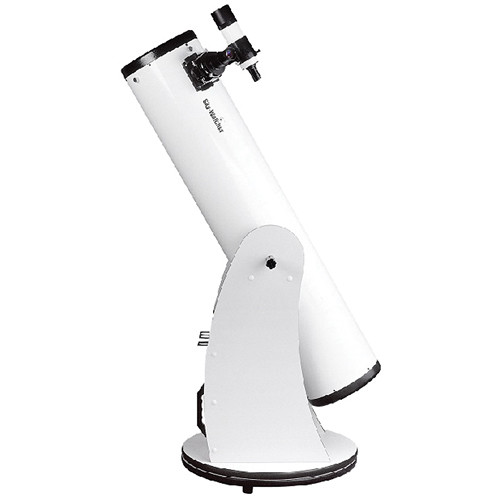
The best brands of consumer telescopes include Meade Instruments, Celestron, Skywatcher, Orion, and iOptron. Some of the GTA telescope vendors include Durham Skies, New Eyes Old Skies, Ontario Telescope, KW Telescope, and Khan Scope. Many of these vendors offer both new and used equipment, which can be a very cost effective solution. Dobsonians in particular can be found used on sites like Kijiji and the Canadian astronomy selling site Astrobuysell, mainly because people find them harder to store. Prices for good, used telescopes range from $250 to $400. If you are buying used, make sure that you try the telescope on a star – to ensure that you can achieve a sharp pinpoint focus. (And use caution when engaging in cash transactions with strangers.)
One last tip – the eyepieces do the job of magnifying. So look for telescopes that accept eyepieces with 1.25” diameter barrels – the standard for quality equipment. That way you can add extra eyepieces, or upgrade to better quality ones later. Here’s an online beginner telescope buying guide from the Backyard Astronomer’s Guide folks.
The Water Constellations – The Lucky Stars of Aquarius
If you missed last week’s tour of the lucky stars of Aquarius (the Water-Bearer), it’s posted here.
Public Astro-Themed Events
Taking advantage of the moon and bright planets in the sky this week, the RASC Toronto Centre astronomers will hold their free monthly public City Sky Star Party in Bayview Village Park (steps from the Bayview subway station), starting around 8 pm on the first clear weeknight this week (Mon to Thu only). You don’t need to be an RASC member, or own any equipment, to join them – looks are free! Check here for details, and check the banner on their website home page or Facebook page for the GO or NO-GO decision around 5 pm each day.
Every Monday evening, York University’s Allan I. Carswell Observatory runs an online star party – broadcasting views from four telescopes/cameras, answering viewer questions, and taking requests! Details are here. On Wednesday nights they offer free public viewing through their rooftop telescopes, including their brand new 1-metre telescope! If it’s cloudy, the astronomers give tours and presentations. Registration and details are here.
On Tuesday, December 3 at 7:30 pm, the Royal Canadian Institute will present 2019 Fleming Medalist Dan Falk in conversation. The event will be held at George Ignatieff Theatre, 15 Devonshire Place, Toronto, ON. Eventbrite registration is here and event details are here.
On Thursday, December 5, starting at 8 pm, U of T’s AstroTour will present the public lecture Exploring the Magnetic Universe by Dr. Cameron Van Eck, followed by stargazing (weather permitting). Details are here.
If it’s sunny on Saturday morning, December 7 from 10 am to noon, astronomers from the RASC Toronto Centre will be setting up outside the main doors of the Ontario Science Centre for Solar Observing. Come and see the Sun in detail through special equipment designed to view it safely. This is a free event (details here), but parking and admission fees inside the Science Centre will still apply. Check the RASC Toronto Centre website or their Facebook page for the Go or No-Go notification.
Weather permitting – on Saturday evening, December 7, from 6 to 8 pm, the Ontario Science Centre will host a free public star party on their Teluscape. Parking fees may apply. Details are here.
This Winter, spend a Sunday afternoon in the other dome at the David Dunlap Observatory! On Sunday afternoon, January 12, from noon to 4 pm, join me in my Starlab Digital Planetarium for an interactive journey through the Universe at DDO. We’ll tour the night sky and see close-up views of galaxies, nebulas, and star clusters, view our Solar System’s planets and alien exo-planets, land on the moon, Mars – and the Sun, travel home to Earth from the edge of the Universe, hear indigenous starlore, and watch immersive fulldome movies! Ask me your burning questions, and see the answers in a planetarium setting – or sit back and soak it all in. Sessions run continuously between noon and 2 pm, and repeat from 2 to 4 pm. Ticket-holders may arrive any time during the program. The program is suitable for ages 3 and older, and the Starlab planetarium is wheelchair accessible. For tickets, please use this link.
Keep looking up, and enjoy the sky when you do. I love questions and requests – so, send me some!